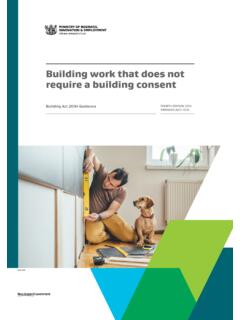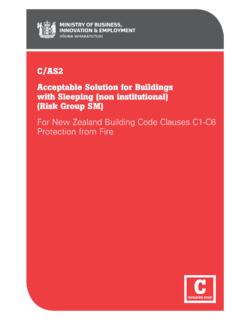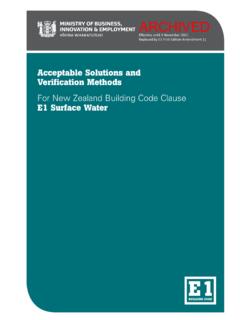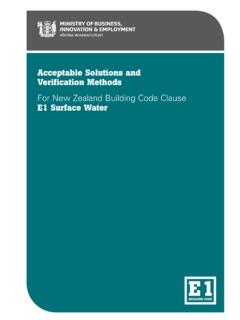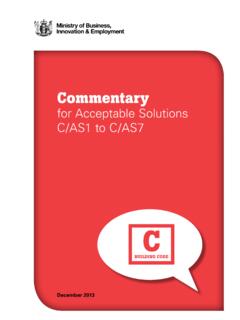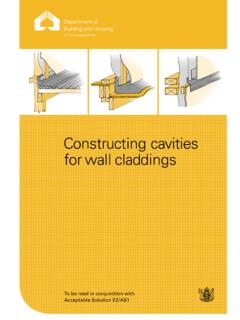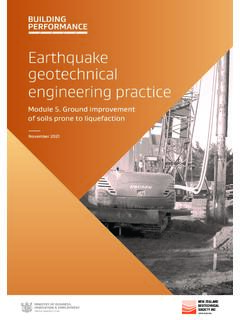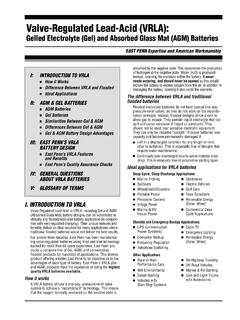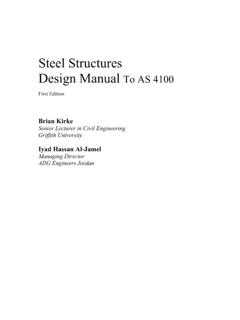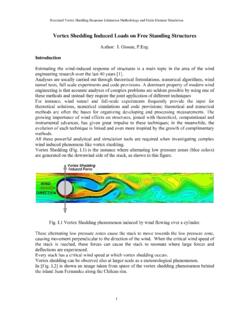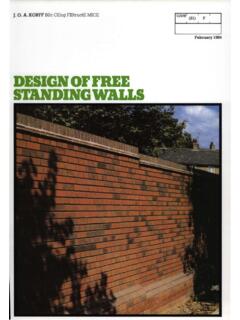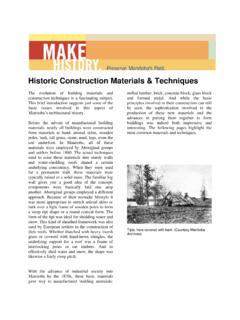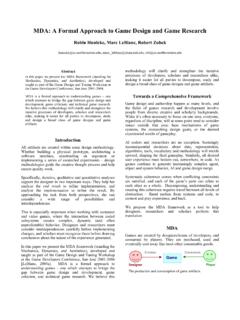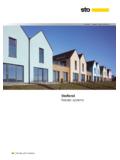Transcription of E2 External Moisture
1 E2 External MoistureVerification Method E2/VM2 Cladding systems for buildings up to 25 m in height including junctions with windows, door and other penetrationsE2 SECOND EDITION | EFFECTIVE 29 NOVEMBER 2021 Page 2E2 External Moisture VERIFICATION METHOD E2/VM2 MINISTRY OF BUSINESS, INNOVATION AND EMPLOYMENT29 NOVEMBER 2021 PrefaceDocument statusThis document (E2/VM2) is a verification method issued under section 22 (1) of the Building Act 2004 and is effective on 29 November 2021. It does not apply to building consent applications submitted before 29 November 2021. The previous Verification Method E2/VM2 First Edition can be used to show compliance until 2 November 2022 and can be used for building consent applications submitted before 3 November Code regulatory systemEach verification method outlines the provisions of the Building Code that it relates to.
2 Complying with an acceptable solution or verification method is a way of complying with that part of the Building Code. Other options for establishing compliance are listed in section 19 of the Building of the Building Code SystemBuildingActBuilding CodeObjectives, Functional requirements,Performance criteriaAlternative SolutionsMust demonstrate compliance with Performance criteriaGuidance issued under the Building ActInformationLegislation (mandatory)Compliance pathwaysDeemed to comply with Performance criteriaAcceptableSolutions** may include cited standards and informationVerification Methods*A building design must take into account all parts of the Building Code. The Building Code is located in Schedule 1 of the Building Regulations 1992 and available online at part of the Building Code that this verification method relates to is clause E Moisture and specifically E2 External Moisture .
3 Further information on the scope of this document is provided in Part 1. information about the Building Code, the objectives, functional requirements and performance criteria provisions that it contains, and other acceptable solutions and verification methods are available at SITS HEREPage 3E2 External Moisture VERIFICATION METHOD E2/VM2 MINISTRY OF BUSINESS, INNOVATION AND EMPLOYMENT29 NOVEMBER 2021 Main changes in this version and features of this documentMain changes in this versionThis is the second edition of E2/VM2. The main changes from the previous version are: The document layout has been revised to improve clarity with additional information on the document and its scope provided in Part 1. General. Reference to the BRANZ EM7 test method for evaluating cladding performance has been amended to the most recent version of the document (version 3) in Appendix A.
4 The new edition allows cladding systems that have already demonstrated compliance under the previous edition to be used without retesting as stated in Part 2. Cladding using this document should check for amendments on a regular basis. The Ministry of Business, Innovation and Employment may amend any part of any verification method or acceptable solution at any time. Up-to-date versions of verification methods and acceptable solutions are available from of this document For the purposes of Building Code compliance, the standards and documents referenced in this verification method must be the editions, along with their specific amendments listed in Appendix A. Words in italic are defined at the end of this document in Appendix B. Hyperlinks are provided to cross-references within this document and to External websites and appear with a blue underline.
5 Appendices to this verification method are part of, and have equal status to, the verification method. Text boxes headed COMMENT occur throughout this document and are for guidance purposes 1. General ..5 Introduction .. 5 PART 2. Cladding systems .. 9 Test specifications .. 9 Appendix A. References ..10 Appendix B. Definitions ..10 Page 4E2 External Moisture VERIFICATION METHOD E2/VM2 MINISTRY OF BUSINESS, INNOVATION AND EMPLOYMENT29 NOVEMBER 2021 ContentsPage 5E2 External Moisture VERIFICATION METHOD E2/VM2 MINISTRY OF BUSINESS, INNOVATION AND EMPLOYMENT29 NOVEMBER 2021 GeneralPart 1. Scope of this E2/VM2 is a means of testing and demonstrating that a wall cladding system will prevent the penetration of water to the extent required by clause of the Building E2/VM2 applies to buildings that fit within the scope of BRANZ : BRANZ EM7 applies to buildings of certain height, forms of construction and structural behaviour.
6 It also has limitations on Inter-storey deflections and peak positive wind pressures on the cladding system. Building consent authorities should accept building consent applications from designers who can demonstrate that the building in the application falls within those limitations. BRANZ EM7 does not have any limits on the negative pressure on the cladding Items outside the scope of this E2/VM2 does not demonstrate the water penetration resistance of window and exterior door units used with the wall cladding : E2/VM2 assesses the junctions of window and exterior door units with other elements of the cladding system, but not the units themselves. Instead it relies on the units having been manufactured to resist water penetration when subject to the relevant design parameters for the there is currently no verification method or acceptable solution for the window and exterior door units for mid-rise buildings, window suppliers may be able to demonstrate, through testing, water penetration resistance of the windows when subject to: Peak positive and peak negative wind pressures acting on the window or exterior door unit (typically calculated in accordance with AS/NZS including all local pressure factors and internal pressures relevant to the location of the window on the building).
7 And The maximum in-plane horizontal movement to which the window or exterior door could be E2/VM2 does not advise quality assurance or inspection procedures to be followed during : As with other building work, a building consent authority should approve appropriate inspection procedures when issuing a building consent for cladding systems whose compliance is based on E2 6E2 External Moisture VERIFICATION METHOD E2/VM2 MINISTRY OF BUSINESS, INNOVATION AND EMPLOYMENT29 NOVEMBER Compliance This verification method is one option that provides a means of establishing compliance with Building Code clause : Building Code clause is reproduced Roofs and exterior walls must prevent the penetration of water that could cause undue dampness, damage to building elements, or Options for demonstrating compliance with the performance criteria of Building Code clause E2 External Moisture through the acceptable solutions and verification methods are summarised in Table Compliance may also be demonstrated using an alternative : In addition to demonstrating that the requirements of this Verification Method are met, its users will need to identify how the building work addresses the following requirements of clause E2: Requirements for roof cladding systems, including requirements for shedding water ( ) and water penetration ( ).
8 Requirements to address Moisture absorbed or transmitted due to ground contact or proximity ( ). Requirements to address the effects of Moisture in subfloor spaces ( ). Requirements to prevent Moisture problems in concealed spaces ( ). Requirements to address construction Moisture ( ). Requirements to make due allowances for consequences, uncertainties and variations ( ).iCOMMENT: Other Building Code clauses may be relevant to the cladding system in addition to clause E2, including clauses: B1 Structure (for the cladding system as well as the building s primary structure) B2 Durability C1 C6 Protection from fire E3 Internal Moisture F2 Hazardous building materials G6 Airborne and impact sound H1 Energy efficiencyTechnical information provided by the suppliers of wall cladding systems should include information that explains how compliance can be Consent Authorities should accept building consent applications from designers who can demonstrate that the requirements of all relevant Building Code clauses have been integrated into the design proposal for a cladding 7E2 External Moisture VERIFICATION METHOD E2/VM2 MINISTRY OF BUSINESS, INNOVATION AND EMPLOYMENT29 NOVEMBER 2021 TABLE.
9 Demonstrating compliance with E2 External Moisture through acceptable solutions and verification methodsParagraph clauseApplies toRelevant acceptable solutions and verification methods Shedding waterAll roofs, except for buildings where External Moisture is unlikely to cause significant impairmentFor timber framed buildings up to 3 storeys, within specific limitations: E2 single- and two-storey concrete roofs and decks with membranes, within specific limitations: E2 light steel framed buildings up to 3 storeys, within specific limitations: E2 Penetration of waterAll roofs and exterior walls, except for buildings where External Moisture is unlikely to cause significant impairmentFor wall cladding systems of timber framed buildings up to 3 storeys, within specific limitations: E2/VM1 Paragraph pitched roofing systems above a roof space, within specific limitations: E2/VM1 Paragraph wall cladding systems of buildings up to 25 m in height, within specific limitations: E2 timber framed buildings up to 3 storeys, within specific limitations: E2 earth building within specific limitations: E2 single- and two-storey concrete and concrete masonry construction within specific limitations: E2 light steel framed buildings up to 3 storeys, within specific limitations: E2 Ground contact or proximityAll walls, floors and structural elements in ground contact or proximity, except for buildings where External Moisture is unlikely to cause significant impairmentFor timber framed buildings up to 3 storeys, within specific limitations: E2 earth building within specific limitations.
10 E2 single- and two-storey concrete and concrete masonry construction within specific limitations: E2 light steel framed buildings up to 3 storeys, within specific limitations: E2 Suspended floorsAll building elements susceptible to damage, except for buildings where External Moisture is unlikely to cause significant impairmentFor timber framed buildings up to 3 storeys, within specific limitations: E2 earth building within specific limitations: E2 single- and two-storey concrete and concrete masonry construction within specific limitations: E2 light steel framed buildings up to 3 storeys, within specific limitations: E2 8E2 External Moisture VERIFICATION METHOD E2/VM2 MINISTRY OF BUSINESS, INNOVATION AND EMPLOYMENT29 NOVEMBER 2021 GeneralPerformance clauseApplies toRelevant acceptable solutions and verification methods Concealed spaces and cavitiesBuilding elements associated with concealed elements and cavities, except for buildings where External Moisture is unlikely to cause significant impairmentFor timber framed buildings up to 3 storeys, within specific limitations: E2 earth building within specific limitations: E2 single- and two-storey concrete and concrete masonry construction within specific limitations: E2 light steel framed buildings up to 3 storeys, within specific limitations.
